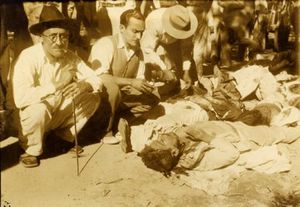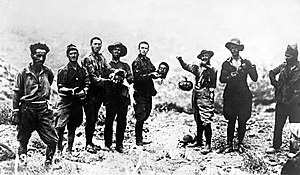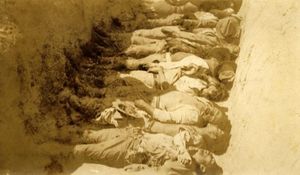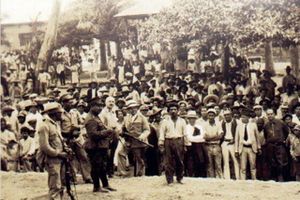Denshire Massacre
| Denshire Massacre | |
|---|---|
 | |
| Location | Denshire, Jakiz, Creeperopolis |
| Date | 13 June 1944 |
| Target | Deltinian Muslims and ethnic Deltinians |
Attack type | Massacre, mass murder, mass rape, genocide, ethnocide, looting |
| Weapons | Firearms, machetes, explosives |
| Deaths | 25,000+ |
| Perpetrators | Militarist Nationalist Front, Romerist Army, Creeperian civilians |
| Assailants | Adolfo Rivera López |
| Motive | Anti-Deltinian sentiment, Islamophobia |
The Denshire Massacre (Creeperian – Creeperian: Մասածրե դե Դենսհիրե; Creeperian – Iberic: Masacre de Denshire), referred to by Deltinians as the Day of Sorrow (Deltinian: يوم الحزن; transliterated as: Yawm al-Huzn), and sometimes referred to by academics as the Denshire Massacre of 1944 or the 1944 Denshire Massacre, was a mass killing and mass rape committed by the Militarist Nationalist Front (FRENAMI) against Deltinian Muslims and ethnic Deltinians in Denshire, the capital city of the Creeperian department of Jakiz. The massacre occurred on 13 June 1944, symbolically the 618th anniversary of the fall of Almadinat Almuqadasa to Creeperian crusader forces during the Creeperian Crusade. During the massacre, paramilitary soldiers of the Militarist Nationalist Front, and some Creeperian soldiers and civilians which joined in the massacre, murdered tens of thousands of unarmed Deltinian civilians who were living in the city. Mass rape, looting, and destruction of mosques also occurred concurrent to the mass killing which was being committed.
An estimated 25,000 Deltinians were murdered during the massacre by the Militarist Nationalist Front, Creeperian Army soldiers, and Creeperian civilians. The massacre occurred during the Creeperian Civil War, when several other infamous massacres occurred, however, the Denshire massacre is considered to be one of the most well known and most controversial. The Creeperian government has been denounced for allowing the massacre to occur within its controlled territory and has also been denounced for the role it played during the massacre.
Despite its infamy and notoriety, the Creeperian government denies the existence of the massacre, instead, stating that "only" 64 communists and revolutionaries were executed after an attempted uprising in the city. The Creeperian government also denies any participation in the massacre. Nationalists in Creeperopolis often deny the massacre or present revisionist historical accounts of the massacre. The Catholic Imperial Restoration Council and subsequent Creeperian government have claimed that the massacre was fabricated as propaganda by the National Council for Peace and Order in an effort to gain the support of Deltinians living in their controlled territory, as in 1937, the National Council itself committed a massacre of Deltinians which killed anywhere from 3,139 to 328,000 Deltinians.
Contents
Background
Creeperian–Deltinian ethnic and religious tensions
| This article is part of a series on |
| Anti-Deltinian sentiment |
|---|
 |
Since the arrival of Deltinians in Sur in 734 and their subsequent conquest of the Kingdom of Creeperia in 745, ethnic and religious tensions between the two groups have been common throughout their shared history. The first major instances of overt ethnic and religious violence between the two groups occurred during the Creeperian Crusade between 1231 and 1345, where both groups massacred the other; Deltinians massacred Creeperans and Creeperian Catholics, and Creeperans massacred Deltinians and Deltinian Muslims. Tensions culminated in the massacre of Almadinat Almuqadasa on 13 June 1326 and the massacre of Shata' Albahr on 25 December 1345.
On 14 June 1326, Creeperian King Miguel I proclaimed the Decree of La'Victoria, which outlawed the practicing of Deltinian Islam within Creeperopolis' domains. Practicing the religion was made punishable by death, beginning the First Great Persecution of Deltinian Islam which lasted from 1326 until 1600, when the decree was nullified and rendered void by the First Parliament. During the nearly-three hundred year period of persecution, an estimated "millions to tens of millions" of Deltinian Muslims were killed. The largest instance of ethnic and religious violence between the two groups between 1600 and 1839 was the 1620 Abdan race riot, during which, a race riot against Deltinians and Muslims, killing Badri al-Morad, the first Deltinian member of the First Parliament, and 1,418 other Deltinian civilians.
On 4 May 1839, Creeperian Emperor Adolfo III proclaimed the Decree of San Salvador, again outlawing the practicing of Deltinian Islam in Creeperopolis. Between 800,000 and 1.2 million Deltinians and Deltinian Muslims were killed between 1839 and 1887 in the Second Great Persecution of Deltinian Islam. The persecution was ended on 31 December 1887 when the Second Parliament nullified it and rendered it void. Because of the second persecution and the role that several right-wing politicians had in its execution, the overwhelming majority of Deltinians and Deltinian Muslims aligned themselves politically with the left-wing People's Social Coalition, mostly voting for the Creeperian Socialist Party (PSC). Throughout the Second Parliamentary Era, the party had attempted on various occasions to reconcile Creeperian–Deltinian relations and to have those responsible for the second persecution brought to justice, increasing their popularity with the people.
In 1921, the far-right Creeperian Pro-Fatherland Front was established by Carlos Hernández Videla, and throughout its "reign of terror" during the Second Parliamentary Era, the group utilized its paramilitary Camisas Negras to intimidate its political opponents. The group also, however, also targeted, attacked, and killed Deltinians and Deltinian Muslims as a part of their ultranationalistic ideological beliefs. The attacks increased Deltinian and Deltinian Muslim support for the political-left, however, they opposed the far-left and their anti-theist policies, particularly the Creeperian Social Communist Party and their Atheist Red Army.
Upon the outbreak of the Creeperian Civil War, the Deltinians and Deltinian Muslims were unable to align themselves with either side of the war, as on one side was the far-right, fundamentalist Catholic, and fascistic Catholic Imperial Restoration Council, and on the other side, was the far-left, fundamentalist Atheist, and communistic National Council for Peace and Order. On 7 May 1937, hundreds of thousands of Deltinians, led by Muammar al-Koroma, a Deltinian imam, revolted against the authority of the National Council after the Huetapán Massacre, in which the National Council executed 24 Deltinian imams for practicing Deltinian Islam. The rebellion, which occurred in Abdan, Helam, and Jakiz, historically referred to as the "Deltinian departments," was crushed by the National Council by 17 May 1937. General Pascual Espinar Casaus reported that his soldiers killed 3,139 "rebelling Deltinian guerrillas," while Deltinians claimed that the National Council systemically massacred up to 328,000 Deltinians, mostly civilians. Modern historians believe that the death toll was somewhere around the 50,000 to 100,000 range, however, the figure of 328,000 is still the most commonly spread figure due to both anti-communist and anti-islamic sentiment in Creeperopolis.
After the suppression of the rebellion, Deltinian opposition to the National Council increased, however, the continued to oppose the Imperial Council as well. Many Deltinians came under attack from both the Camisas Negras and the Atheist Red Army in the aftermath of the rebellion, and news of the high death toll of the rebellion and massacre spread across Creeperopolis.
Military situation
When the civil war broke out on 2 January 1933, the National Council gained control of the capital city of Jakiz: Denshire. The city was held firmly by the National Council throughout the 1930s and into the early 1940s. During their occupation, on 25 April 1938, the National Council arrested 35 religious figures in the city, including 12 imams, and had them executed for being religious figures.
On 1 June 1943, the Imperial Council began the Southern Offensive of 1943–44. Commanded by Field Marshal Arturo Rawson Perón, the offensive's objective was to capture and secure the "Deltinian departments" of Abdan, Helam, and Jakiz. On 1 September 1943, the 15th Romerist Army, led by General Rafael Dávalos Villa, began the Battle of Denshire. After two weeks and three days of fighting, General Jairo Carballar Alcocer's 19th Miguelist Army was forced to retreat from the city on 18 September 1943, ending the battle in a National Council victory.
Over 4,800 military personnel were killed during the battle and an estimated 1,300 civilians were killed, however, not many civilians were displaced from the city. By the start of 1944, most of the civilians who were displaced from the city by the battle were able to return and rebuild their homes. By June 1944, most of the city had been rebuilt by those living in the city. After the battle, the 99th Romerist Infantry Regiment under Colonel José Blázquez Cuevas, consisting of 1,500 soldiers, was garrisoned in the city.
Assassination of Adolfo Cabañeras Moreno
On 9 May 1944, Supreme Caudillo Adolfo Cabañeras Moreno, the Minister of Defense of the Imperial Council, and Field Marshal Luís Sánchez Cerro, the most senior Castillianan military official in Creeperopolis, were assassinated by operatives of the Atheist Red Army while working for the National Council. The decapitation strike against the Romerist and Castillianan Armies caused outrage within the Imperial Council, and following the assassination, several massacres were committed by the Imperial Council against civilians who sympathized with the National Council.
Planning of the massacre
The assassination also caused outrage among the soldiers and leaders of the Militarist Nationalist Front (FRENAMI), a paramilitary death squad which was allied with the Imperial Council. Its leader, Adolfo Rivera López, who had ordered dozens of massacres in the past, ordered his men to kill as many communists and atheists as possible before the month ended. He realized, however, that targeting communists and atheists would be difficult due to the civil war, so he instead decided to execute a large massacre within a city against a defenseless group of people in order to "make a statement" in regards to the assassination.
Rivera López decided to massacre a city's entire population of Deltinians and Deltinian Muslims, largely due to the history of ethnic and religious tensions between the two groups, but also due to his own personal racist views, as he considered Deltinians to be "subhuman," and as the anniversary of the Massacre of Almadinat Almuqadasa was approaching in June. He decided to massacre the Deltinians in the city of Denshire, as it was firmly in the hands of the Imperial Council and it is also symbolically the final city to fall during the Creeperian Crusade, when it was known as Shata' Albahr.
He and his paramilitary death squad were in San Salvador when the decision was made in mid-May 1944 to massacre the Deltinians in Denshire. Throughout late-May and early-June 1944, he and his 350 men marched through San Salvador, Zapatista, Helam, Abdan, and Jakiz, killing as many communists, atheists, Senvarians, and Deltinians as they could along the march. They arrived outside of Denshire on 12 June 1944, the day before the massacre was planned to occur. The night before the massacre, five Deltinians were abducted from the outskirts of the city and forced them to commit blasphemy against Allah and Muhammad under threat of torture and death. They were eventually tortured and beheaded, after being told that they would not be if they committed blasphemy against their god and most revered prophet. The abduction, torture, and execution was done as a sort of "good luck ritual" before the massacre was to occur.
Massacre
Organized executions
On 13 June 1944 at 5:30am local time, soldiers of the Militarist Nationalist Front entered western Denshire, where most Deltinians lived, and began breaking into homes and forcing those inside to wake up and march outside of their homes. During the initial phases of the massacre, the soldiers were careful to ensure that the people they were killing were in fact Deltinians, the soldiers checked if the males of households were circumcised, and if they were, the entire family was lined up against a wall and executed by firing squad. After an execution, the soldiers tended to loot the home they broke into to search for any valuables, both containing direct value to the death squad as a whole, such as food and weapons, and containing value only to an individual, such as antiques and gold items which could be sold later for a solder's personal profit.
For the first hour of the massacre, the Militarist Nationalist Front went door to door, forcing the people inside out of their homes, making sure they are Deltinian, and executing the household outside their homes. During the first hour, around 1,260 Deltinians were murdered by the Militarist Nationalist Front.
Mass killings
By 6:30am local time, soldiers began to notice that the Deltinians had begun to flee from their homes, seeing the ongoing massacre of their fellow Deltinians. The soldiers quickly abandoned the orderly organized executions of Deltinians and instead resorted to killing Deltinians on the spot, and instead of checking for circumcision, they checked merely on appearance. If the person looked like a Deltinian, the person would be murdered by the soldiers.
Chaos ensued in the city, as Deltinians began rushing east, deeper into the city where the more Creeperian population lived. Creeperans noticed the ongoing mass panic of Deltinians and attempted to force them back east, out of the Creeperian areas of the city. Mobs began to form and began attacking Deltinians, forcing them to flee back towards the Militarist Nationalist Front, or even killing Deltinians themselves out of their own racial prejudice, or even for personal grievances.
José Núñez Barceló, the Mayor of Denshire, was made aware of the ongoing mass chaos and massacre occurring in the Deltinian section of the city and quickly ordered 99th Romerist Infantry Regiment to intervene, stop the Militarist Nationalist Front, and restore peace in the city. Blázquez Cuevas led his men to stop the massacre, but when he saw that Deltinians were the ones being killed, he ordered his soldiers to return to the barracks and to allow the massacre to unfold. Some soldiers, however, stayed behind, and began participating in the massacre themselves.
On one occasion, hundreds of Deltinians sought refuge in the one mosque that was in the city for them to worship in. The Militarist Nationalist Front noticed the Deltinians running into the mosque and eventually blocked off all access into or out of the mosque. Soldiers se the mosque on fire and burned it to the ground, murdering around 250 people in the process.
By midday, around 11,000 Deltinians had been murdered, and the streets of Denshire were overflowing with corpses. Some soldiers began to dig mass graves for the corpses being left in the city, as it was becoming difficult for them to carry their loot out of the city while attempting to navigate the piles of bodies which covered the ground. Some Deltinians were even captured and forced to dig mass graves themselves and to assist in dumping bodies into the graves, only to be shot themselves and thrown into the mass grave.
At 3:00pm local time, a mob of Deltinians attempted to break into the barracks where the 99th Romerist Infantry Regiment was garrisoned. The regiment's soldiers fired upon the mob, killing many and dispersing the rest. After the incident, Blázquez Cuevas ordered his men back to the massacre zone and ordered his soldiers to assist the Militarist Nationalist Army in killing Deltinians in a form of revenge and punishment for the attempted break in of the barracks.
Efforts to halt the massacre and hide Deltinians
Although many Creeperian civilians joined in the massacre themselves, as did the Army garrison of the city, there were still many Creeperans who attempted to save as many Deltinians as they could from the Militarist Nationalist Front. Initially, Deltinians who fled before they were to be executed fled into a neighbor's home who was Creeperian and hid so that the Militarist Nationalist Front would leave the home alone, but as the death squad began killing people based on assumptions and appearance, Deltinians needed to flee further and further for safety. Creeperans let Deltinians into their homes, however, some only accepted Deltinian girls and women, as the boys and men would be unable to be hidden well, and they were forced to flee further, and some even had to flee the city entirely. People who were caught sheltering Deltinians were executed by the Militarist Nationalist Front or were burned alive inside of their homes.
Núñez Barceló ordered the Civil Police to bring an end to the massacre, however, many did not want to attempt to do so as they were out numbered and were at a severe disadvantage with the weapons they had available, some simply were apathetic and did not want to stop the massacre, and some even had sympathies with the Militarist Nationalist Front, with some even joining in the massacre.
The most famous and well-known instance of someone helping hide and shelter Deltinians to prevent them from being murdered by the Militarist Nationalist Front was that of Núñez Barceló himself. During the massacre, he allowed Deltinians to take refuge in the mayoral palace in the city, hiding them in the palace's basement. Sometime during the massacre, a Creeperian noticed him allowing Deltinians to hide in the mayoral palace and he managed to send a tip to the Militarist Nationalist Front, informing the death squad about what Núñez Barceló was doing.
Soon, around fifty soldiers marched on the mayoral palace, killing Deltinians along the way, and fought with guards who were defending the mayoral palace. The soldiers forced their way in and captured Núñez Barceló. They searched the palace in search of Deltinians and eventually found 532 Deltinians hiding in the basement of the mayoral palace. The soldiers fired shots into the crowd of Deltinians who were hiding, but then decided to throw explosives in the basement. They then locked the basement shut and set fire to the mayoral palace, killing all the Deltinians inside.
The ten mayoral palace guards who were captured by the Militarist Nationalist Front were hanged on poles throughout the city for helping Núñez Barceló hide and shelter Deltinians. Núñez Barceló himself was abducted by the soldiers and taken to where the massacre was occurring. Rivera López himself berated Núñez Barceló about defending and sheltering Deltinians, telling him that he had "demoted himself" to the status of a Deltinian in the eyes and perspective of the Militarist Nationalist Front. Many soldiers, of both the death squad and the Army, and even some civilians gathered to witness the execution of Núñez Barceló. Núñez Barceló was shot by a firing squad of death squad soldiers at 5:32pm local time. He was shot seven times, but the bullet wounds did not kill him. He then had a noose tied around his neck and he was hanged. After ten minutes, he was still alive, so he was brought down and decapitated. Núñez Barceló was one of several Creeperans who were killed for defending and sheltering Deltinians.
End of the massacre
At sunset, soldiers conducted their final killings, and the Militarist Nationalist Front withdrew from the city. The group abducted around 40 Deltinian children who the death squad would forcibly conscript into fighting for the death squad. The death squad killed more Deltinians as they were marching out of the city. The 99th Romerist Infantry Regiment returned to its barracks after a day of committing mass murder, mass rape, arson, and looting against the city's own Deltinians. Creeperian mobs continued to murder and rape Deltinians after both the Militarist Nationalist Front and Army had already withdrawn. The last acts of violence of the Denshire Massacre occurred around 11:00pm local time, when the last family of Deltinians was hacked to death with machetes by a mob.
Aftermath
The Deltinian sector of Denshire was left in ruins following the massacre. The sector of the city was effectively razed to the ground with most homes being burned down or destroyed with explosives, with many of the fires raging through the night and continuing through to the following week.
Graffiti was sprayed on many buildings. Most of the graffiti was destroyed, however, some buildings survived the fires which plagued the sector, and their graffiti work survived. The Militarist Nationalist Front wrote messages such as "The Sombra Negra[note 1] rules this city" and "The Deltinians did not stand a chance" on many buildings in the city.
Death toll
Corpses scattered the entire Deltinian sector of the city and open mass graves were on every street. During the massacre, around 25,000 Deltinians and Creeperans who attempted to shelter them were murdered by the Militarist Nationalist Front, the Army, and Creeperian mobs. Many corpses remained on the streets for days, weeks, and months after the massacre. The massacre, however, is not the deadliest of the Creeperian Civil War, as the massacre of the Deltinians by the National Council in 1937, was and remained as the largest massacre of the civil war. The massacre was, however, the deadliest massacre committed by the Imperial Council during the civil war.
Efforts for justice
The government of Greater Sacramento offered asylum to any Deltinians fearing for their lives in accordance to the 1853 Sacramatian Asylum Act.
Creeperian denial of the massacre
Subsequent attacks against Deltinians
Legacy
In popular culture
Films
Literature
Memorials
See also
Notes
- ↑ "Sombra Negra" is a common nickname for the Militarist Nationalist Front.





